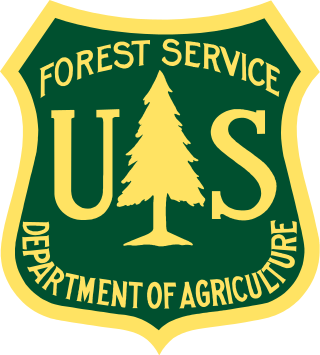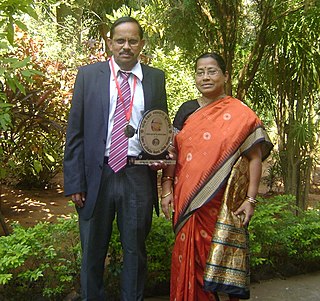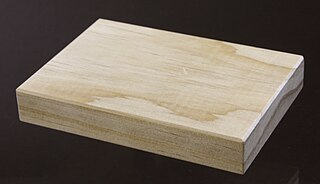Craig Jon Hawker is an Australian-born chemist. His research has focused on the interface between organic and polymer chemistry, with emphasis on the design, synthesis, and application of well-defined macromolecular structures in biotechnology, microelectronics, and surface science. Hawker holds more than 45 U.S. patents, and he has co-authored over 300 papers in the areas of nanotechnology, materials science, and chemistry. He was listed as one of the top 100 most cited chemists worldwide over the decade 1992–2002, and again in 2000–2010.

The Forest Products Laboratory (FPL) is the national research laboratory of the United States Forest Service, which is part of USDA. Since its opening in 1910, the FPL has provided scientific research on wood, wood products and their commercial uses in partnership with academia, industry, tribal, state, local and other government agencies. The laboratory is headquartered in Madison, Wisconsin. The focus of the Forest Products Laboratory is to promote healthy forests and forest-based economies through the efficient, sustainable use of the Nation's wood resources.
Gilbert Stork was an organic chemist. For a quarter of a century he was the Eugene Higgins Professor of Chemistry Emeritus at Columbia University. He is known for making significant contributions to the total synthesis of natural products, including a lifelong fascination with the synthesis of quinine. In so doing he also made a number of contributions to mechanistic understanding of reactions, and performed pioneering work on enamine chemistry, leading to development of the Stork enamine alkylation. It is believed he was responsible for the first planned stereocontrolled synthesis as well as the first natural product to be synthesised with high stereoselectivity.
Peter Berghsey Johnsen is an American scientist, administrator and adventurer.
Arlie William Schorger was a chemical researcher and businessman who also did work in ornithology. His chemistry work of note largely involved wood and waterproofing. His only chemistry book was The chemistry of cellulose and wood, but he had 34 patents.
Lawrence F. Dahl was an R.E. Rundle and Hilldale Professor of Chemistry at the University of Wisconsin–Madison. Dahl was an inorganic chemist, and his research focused on high-nuclearity metallic compounds. He was elected to the National Academy of Sciences in 1988.
Impregnation resins are slightly viscous, organic liquids that are used in the forest products industry for wood modification. They typically contain formaldehyde and are composed of dimers and trimers of the main molecule. These can become polymer solutions upon curing inside of a wood substrate, imparting stabilizing properties. Impregnation of these resins involves a vacuum chamber procedure that completely disperses the resin into the wood. Once inside of the wood, the resin can diffuse into the cell wall and enhance the physical strength of the wood even further.
John Douglass Ferry was a Canadian-born American chemist and biochemist noted for development of surgical products from blood plasma and for studies of the chemistry of large molecules. Along with Williams and Landel, Ferry co-authored the work on time-temperature superposition in which the now famous WLF equation first appeared. The National Academy of Sciences called Ferry "a towering figure in polymer science". The University of Wisconsin said that he was "undoubtedly the most widely recognized research pioneer in the study of motional dynamics in macromolecular systems by viscoelastic techniques".

Wood science is the scientific field which predominantly studies and investigates elements associated with the formation, composition and macro- and microstructure of wood. It additionally delves into the biological, chemical, physical, and mechanical properties and characteristics of wood, as a natural lignocellulosic material.
Catherine "Cathy" J. Murphy is an American chemist and materials scientist, and is the Larry Faulkner Professor of Chemistry at the University of Illinois at Urbana-Champaign (UIUC). The first woman to serve as the head of the department of chemistry at UIUC, Murphy is known for her work on nanomaterials, specifically the seed-mediated synthesis of gold nanorods of controlled aspect ratio. She is a member of the American Association for the Advancement of Science, National Academy of Sciences, and the American Academy of Arts and Sciences in 2019.

Ganapati Dadasaheb Yadav is an Indian chemical engineer, inventor and academic, known for his research on nanomaterials, gas absorption with chemical reaction and phase transfer catalysis. He served as the vice chancellor of the Institute of Chemical Technology, Mumbai from 2009 until November 2019. He is currently the Emeritus Professor of Eminence at ICT Mumbai.
Murali Sastry is an Indian material chemist, nanomaterial scientist and the chief executive officer of the IITB-Monash Research Academy. He is a former chief scientist at Tata Chemicals and a former senior scientist at the National Chemical Laboratory. He is known for his studies on surfaces, films and materials chemistry and is an elected fellow of Maharashtra Academy of Sciences and the Indian Academy of Sciences. The Council of Scientific and Industrial Research, the apex agency of the Government of India for scientific research, awarded him the Shanti Swarup Bhatnagar Prize for Science and Technology, one of the highest Indian science awards, in 2002, for his contributions to chemical sciences.

The Old U.S. Forest Products Laboratory, built in 1910 in Madison, Wisconsin, housed a new national lab, and the first institution in the world created specifically to research wood and wood products. Research in this building produced breakthroughs in wood preservation, laminates, and paper production. The building itself is a good example of Georgian Revival-style architecture. In 1985 the building was added to the National Register of Historic Places.

Professor Kulamani Parida, also known as K. M. Parida is an Indian chemical science professor and scientist best known for his work and research, mainly on material chemistry. He has won 16 state and national level scientific awards, and authored around 425 research articles, and seven book chapters. Parida has also 35 national scientific patents. Parida has also an outstanding google scholar citation index with citations of ~19279, h-index ~73, and i10-index ~335.

Richmond Jay Bartlett was an American soil scientist and professor. He received his BS degree (Biology) in 1949 and his PhD in 1958, both from the Ohio State University, in Columbus. He spent the next 40 years at the University of Vermont in Burlington. Upon his retirement in 1997 he was named professor emeritus, a rank he retained until his death in 2005. Bartlett was known for his creative approach to the study of soils and how they function in ecological systems, especially at the molecular and colloidal levels. He was able to apply scientific concepts to farming and ecology in ways that allowed the practical and theoretical to inform each other. The focus of his research with his graduate students was on oxidation-reduction chemistry, soil acidity, and soil testing. He became known for this thoughtful summary of the nature of soils:
T Govindaraju is a professor in the Bioorganic Chemistry Laboratory at Jawaharlal Nehru Centre for Advanced Scientific Research, Bengaluru. The researchers in the Bioorganic Chemistry Laboratory work in areas which lie at the intersection of chemistry, biology and biomaterials science, and in particular, on problems related to Alzheimer's disease, peptide chemistry, molecular probes, molecular architectonics, nanoarchitectonics and biomimetics.
Alfred J. Stamm (1897–1985) was an American wood scientist, who worked at the Forest Products Laboratory and was a Member of the International Academy of Wood Science. His research contributions in the acetylation of wood has been well recorded.
George Mantanis is a Greek wood scientist and professor at the University of Thessaly, who is an elected fellow (FIAWS) of the International Academy of Wood Science.

Acetylated wood is a type of modified wood that is ecologically friendly and does not contain toxic substances. It produced from a special chemical treatment (acetylation) involving acetic anhydride and a chemical modification process to make wood highly resistant to biological attacks by fungi and wood-boring insects, ensuring a long lifespan and durability in various environmental conditions. It is a novel wood product in the field of wood science, following several decades of research and experimentation.
John Ralph is a New Zealand-born, American chemist and researcher, and professor at the University of Wisconsin-Madison, who is an elected fellow (FIAWS) of the International Academy of Wood Science and the American Association for the Advancement of Science (FAAAS).







